To access the other concept sheets in the Tourism unit, consult the See Also section.
The Gaspésie tourist region is located in the southeast of the province of Quebec. It is a peninsula covering nearly 30 341 km2[1]. It is surrounded by 3 bodies of water:
-
St. Lawrence River
-
Gulf of St. Lawrence
-
Baie des Chaleurs
A peninsula is a place where the land extends into the sea.
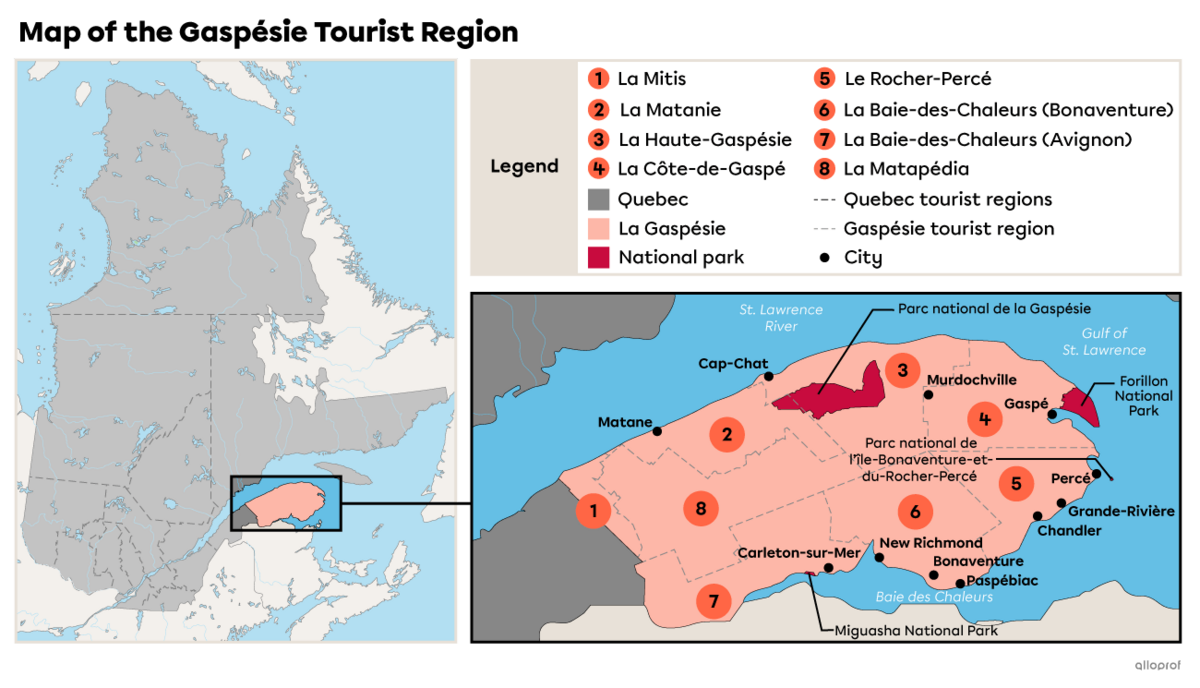
Gaspésie is one of 20 tourist regions in Quebec.
Gaspésie is renowned as one of Quebec's most beautiful tourist destinations. It has even been ranked more than once as one of the best destinations in the world by National Geographic magazine.
The many spectacular landscapes are what make Gaspésie so popular. The region is criss-crossed by the Chic-Choc Mountains, which are part of the Appalachian mountain range. Baie-des-Chaleurs offers numerous beaches.
This diversity of landscapes and attractions allows visitors to enjoy many forms of tourism, including beach tourism, adventure tourism, cultural tourism, ecotourism and even culinary tourism.
Percé Rock is the emblem of the Gaspé Peninsula. Its name comes from the arch-shaped hole carved out by the sea. It is also a haven for birds.
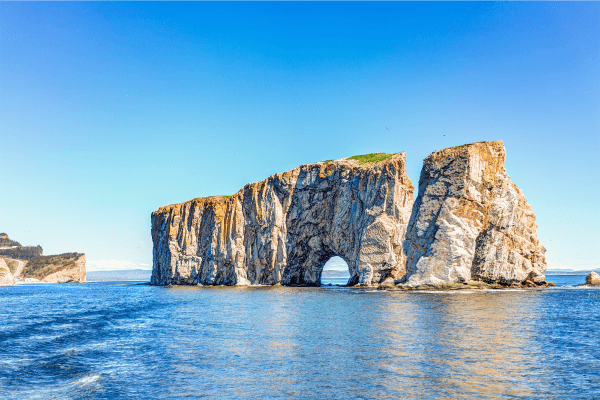
It is 450 m long, 90 m wide and 85 m high[2].
Source: Kristi Blokhin, Shutterstock.com
The Chic-Chocs Mountains are made up of several peaks, 25 of which exceed 1000 metres. The Réserve faunique des Chic-Chocs offers a variety of activities and accommodation for tourists interested in ecotourism.
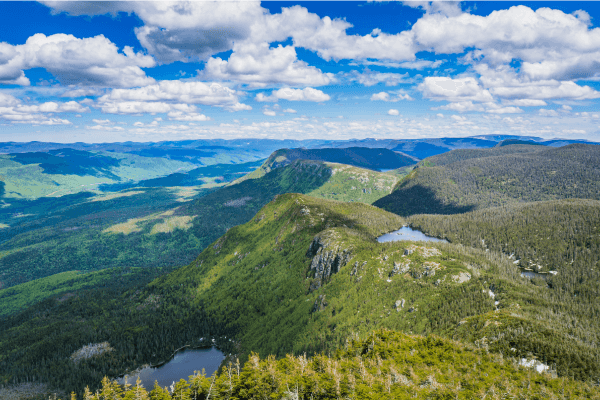
Outdoor activities include hiking, hunting and fishing, kayaking and much more. In winter, visitors can enjoy alpine skiing, cross-country skiing or snowshoeing.
Source: Pernelle Voyage, Shutterstock.com
The Gespeg Micmac Interpretation Site offers an opportunity to learn more about the history, beliefs and traditional way of life of the 17th-century Mi’kmaq.
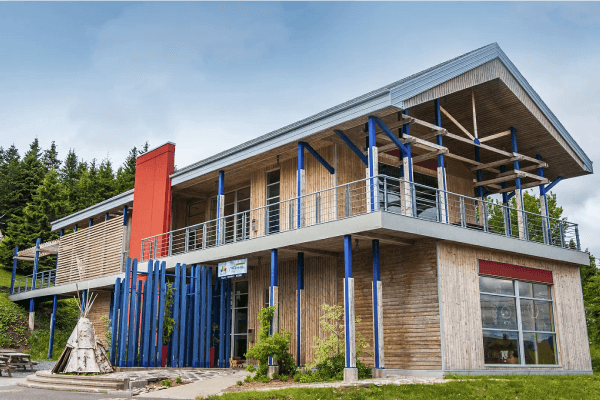
The interpretation site also offers several workshops for making traditional objects, such as dreamcatchers, traditional baskets and more.
Source: The Gespeg Micmac Interpretation Site [Photograph], Levasseur, Marilou, n.d., Tourisme Gaspésie (URL). Rights reserved*[3]
The Forillon peninsula is located near the town of Gaspé and is a very popular attraction with visitors. Seascapes blend with mountain landscapes. You can observe many species of animals, including seals and 6 different species of whales, as well as black bears, moose and many types of birds.
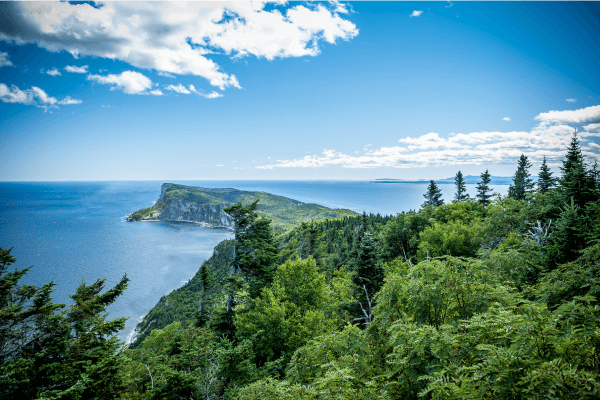
It covers the entire peninsula. Many activities are available, including hiking, sea kayaking, snorkelling, swimming and cycling.
Source: Pierrette Guertin, Shutterstock.com
The Gaspésie region is renowned for its excellent ocean products, such as fish and seafood. As a result, culinary tourism has taken root in the region.
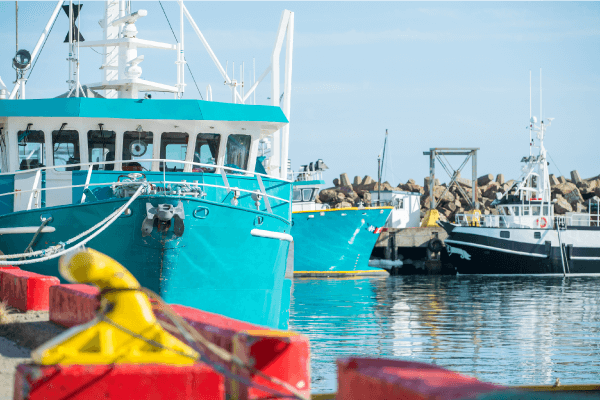
Source: Fotorebel, Shutterstock.com
In order to welcome visitors to Gaspésie, the region's many landscapes and attractions need to be developed. These infrastructures must not only meet the needs of tourists, but also enhance the various attractions.
As a large proportion of Gaspésie's attractions are nature-based (mountains, beaches, sea), several national parks have been developed. The Gaspésie region boasts 3 provincial national parks.
-
Parc national de la Gaspésie
-
Miguasha National Park
-
Parc national de l'Île-Bonaventure-et-du-Rocher-Percé
Gaspésie also has a federal national park, Forillon National Park.
National parks are designed to accommodate tourists while preserving landscapes and ecosystems. Campgrounds and chalets are set up to accommodate visitors. In addition, facilities and infrastructures are installed to enable the practice of various activities, such as marked trails for hiking or mountain biking, or places to rent equipment such as canoes and kayaks.
These types of infrastructure enable tourists to enjoy a wide range of activities in an organized and environmentally sustainable way.
An ecosystem is the sum of relationships between a physical environment and all the living beings within it.
Tourist routes have also been developed for the Gaspésie region. The circuits are organized around different themes and follow an itinerary that offers attractions and activities related to the theme.
|
The Grand Tour |
This tourist route follows Route 132 in a loop around the Gaspé Peninsula. This 885-km circuit includes 76 attractions and over 210 activities. |
|
The Lighthouse Route |
The Lighthouse Route features a tour of the region's 14 lighthouses. |
|
The Arts Circuit |
This circuit introduces you to Gaspésie’s artisans and artists via 11 different attractions. |
|
The Historical Circuit |
This circuit explores 29 attractions, including the Musée de la Gaspésie and Percé's historical circuit, to learn more about the region's history. |
|
The Wildlife Observation Circuit |
This circuit features 13 activities that allow visitors to observe the region's wildlife, with stops at the Bioparc, Réserve faunique de Matane and more. |
|
The Marine Mammal Observation Circuit |
This circuit features 11 activities, including sea kayaking, scuba-diving, cruises and sailing. |
|
The Gaspésie Gourmande Circuit |
This circuit offers an itinerary that allows you to meet the region's various producers and food artisans with over 20 places to visit. |
The region also offers other tourist facilities, such as:
-
inns
-
lookouts
-
rest stops
-
tourist information centres
-
picnic areas
-
observation points
Tourism has replaced some of the economic activities that were once vital to Gaspésie’s economy, such as mining, forestry and seafood. Tourism creates many jobs in the lodging (hotels, campgrounds) and food service (restaurants, local products) industries, contributing to the region's economic development. In 2022, the economic benefits of tourism in Gaspésie were estimated at $340 million[4].
However, tourism doesn't only have positive impacts. It also has negative impacts that can jeopardize the protection of the region's tourist attractions and its environment.
Many of Gaspésie's tourist attractions are tied to its landscape. Yet many activities take place in the same area. Infrastructure such as electricity pylons or logging areas can affect tourism by altering landscapes and causing them to lose their beauty.
Coordinating development to meet different needs is one way of protecting the landscapes that tourists are looking for. This way, different needs can be met. The creation of protected areas, such as wildlife reserves or national parks, also helps to preserve landscapes.
Created in 2013, the Charte des paysages de la Gaspésie has been adopted by numerous organizations. It aims to raise awareness on the importance, but also the fragility, of the landscapes in Gaspésie. It also aims to support actions to protect them. The Charter proposes a number of actions to meet these objectives, including:
-
supporting initiatives that help visitors discover the landscapes (such as roadside rest areas)
-
regulating roadside advertising
-
designing villages to reflect the surrounding landscape
The effects of organizing a territory for tourist activities can be detrimental to ecosystems. Animal and plant species are impacted, and some have difficulty adapting which puts them at risk of extinction.
The creation of protected areas, such as a national park, as well as raising tourist awareness of ecosystem protection are two ways of reducing negative effects.
There is only one group of caribou south of the St. Lawrence River. It is found in Gaspésie, more precisely in the Parc national de la Gaspésie.
In 1980, the caribou population in Gaspésie was estimated to be 200 animals. By 2022, it had dwindled to just 34[5].
The causes of this sharp decline in caribou numbers are mainly related to human activity. Deforestation caused by logging, for example, has greatly reduced caribou habitat. Nature tourism also plays a role in the disappearance of this species. The presence of hikers alters caribou behaviour and exposes them to greater danger.
Several measures have been put in place to try to protect the caribou, such as better control of visitor movements in Parc national de la Gaspésie. Workshops are also offered to visitors to inform them about ways to protect this species.
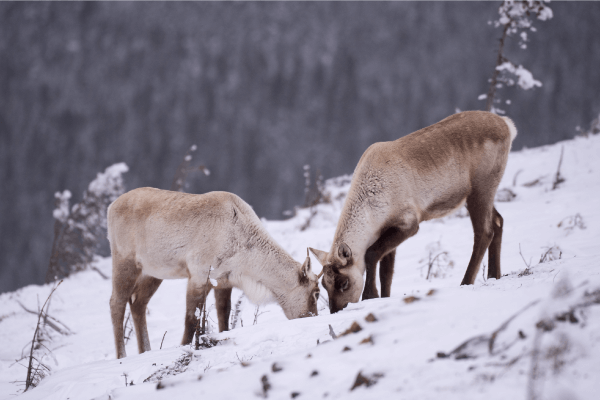
Source: RRichard29, Shutterstock.com
The Gaspésie region is experiencing a housing crisis with residents finding it extremely difficult to find an apartment in the region. Tourism is exacerbating the situation.
Many people have to leave their homes during the tourist season. Indeed, some landlords only agree to rent out their properties if the tenants leave during the summer. This allows them to rent to tourists at a much higher price during these few months.
This creates "hidden homelessness" meaning some Gaspesians find themselves camping outside or living in their cars or trailers during the summer. This can be particularly difficult for families. Often, people feel obliged to accept these conditions because of the scarcity of available housing.
The 2020 Gaspésie tourist season made headlines across the province. Due to Covid-19 restrictions, international borders were closed and access to other provinces was limited. People wishing to travel had to do so within the province of Quebec.
Gaspésie was the choice for many, with some 1 million tourists visiting the region in the summer of 2020[6]. As a result, many people toured the region during the months of July and August. This resulted in many problems, such as traffic jams, crowded beaches, queues and so on.
There were also too many people for the accommodation available. People ended up camping all over the place, on beaches, in fields, on private land and sometimes directly in protected areas where ecosystems were already fragile.
Many of the visitors left garbage everywhere, partied and made noise until very late at night, used illegal fireworks and much more. These actions were detrimental to the residents' quality of life.
In subsequent years, the Gaspésie authorities tried to stretch out the tourist season to reduce the number of people on the territory at one time. This reduced pressure on the tourism industry.
To access the rest of the unit, consult the following concept sheets.
-
Association touristique régionale de la Gaspésie. (n.d.). Quel itinéraire choisir pour votre tour de la Gaspésie?. Tourisme Gaspésie. https://www.tourisme-gaspesie.com/fr/16/quel-itineraire-choisir-pour-votre-tour-de-la-gaspesie-/article.html
-
Lechasseur, Antonio. (2015, March 23). Rocher Percé. L’Encyclopédie canadienne. https://www.thecanadianencyclopedia.ca/fr/article/perce-rocher
-
Levasseur, Marilou. (n.d.). Site d'interprétation de la culture Micmac de Gespeg [Photograph]. Tourisme Gaspésie (URL).*Extrait employé par Alloprof conformément à la Loi sur le droit d'auteur dans le cadre d'une utilisation équitable aux fins d’éducation [https://laws-lois.justice.gc.ca/fra/lois/c-42/page-9.html].
-
TourismExpress. (2022, November 25). Gaspésie : Bilan d'une saison touristique atypique. https://tourismexpress.com/nouvelles/gaspesie-bilan-d-une-saison-touristique-atypique
-
Nature Québec. (2022). Caribou de la Gaspésie. https://naturequebec.org/projets/caribou_gaspesie/
-
Bourque, Carmen. (2022, March 11). Tourisme et protection de la nature en Gaspésie. Radio-Canada. https://ici.radio-canada.ca/tele/blogue/1868364/tourisme-gaspesie-mer-protection-environnement-animau